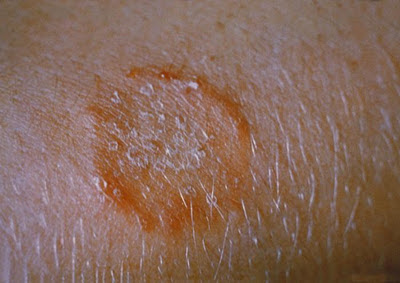 |
| Image is from Wikimedia Commons under a creative commons license. |
This is ringworm! Though many people think that ringworm is caused by a worm, it's actually a fungal infection. Ringworm can occur on various places of the body, including on the scalp, beard, body, feet (as in "athlete's foot"), and the groin area (as in "jock itch"). The fungus is highly contagious, and children are especially susceptible. You are more likely to catch it in places where your skin is commonly wet, which is why it's so often associated with athletes. Cats are known to be a common carrier of the disease.
Symptoms include red, scaly patches with well-defined edges that are often brighter in color than the center. If patches occur in an area which normally has hair, bald patches will occur. This is also seen in affected animals, such as the cow above. Affected nails will become brittle and oddly colored. Diagnosis is simple, due to the characteristic patches, as well as the fact that the fungus will glow under a specific sort of blue light. Other tests can also be used to confirm.
Treatment involves keeping areas clean and dry, avoiding contact with irritating fabrics, and applying anti-fungal agents in whatever form (powder, cream, lotion). Often, over-the-counter treatment will work. Sheets should also be washed daily during the infection. If the infection is especially severe, reoccurring, or in one's hair, pills may need to be prescribed to clear it up.
Prevention includes general good hygiene: keeping yourself clean and dry, shampooing regularly, not sharing someone else's clothing or other personal items, and wearing footwear in wet public areas, such as pools, gyms, and lockers.
 |
| Ringworm on a human. Copyright free from Wikimedia Commons. |

No comments:
Post a Comment